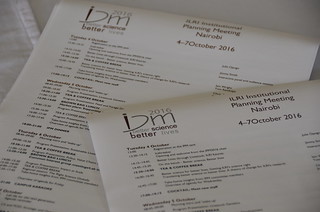BETTER SCIENCE, BETTER LIVES
The International Livestock Research Institute (ILRI),
headquartered in Africa and working in poor countries
worldwide to provide better lives through livestock,
held its Institute Planning Meeting from 4 to 7 Oct 2016.
This is the third of a series of blog articles reporting on
plans for ILRI research programs, including ILRI’s
work in west and southern Africa and south, east and southeast Asia.
ILRI animal feed scientist Michael Blümmel says
mixed farmers can replace sorghum crops with maize
for dual food-feed use on their farms. At least one key
partner along a livestock value chain needs to have good
understanding of its science as well as context.
Collaborating with such experts is a strength of ILRI’s.
—ILRI’s Ben Hack reporting on #ipm2016
ILRI Feed and Forage
Development Program
Vision
The vision of ILRI’s Feed and Forage Development program is that (1) researchers and farmers are using diverse forage germplasm that is accessible and available from a global collection and (2) researchers and development agents are using a comprehensive knowledge base on forage diversity for their selection and development work.
Objectives
Staff of ILRI’s Feed and Forage Development program are working to reduce feed costs and provide improved feeds, forages and feeding strategies to smallholder food producers in developing countries.
Teams
This program has three teams working on feeds and feeding strategies, conservation and use of forage diversity, and making better used of genetic variability in feeds and forages.
Exciting new science
Chris Jones is excited about new AFEX technology
that helps to break down rice straw and increases
its digestibility. He sees large potential for productivity
gains among smallholder food producers.
—ILRI’s Ben Hack reporting on #ipm2016
Among the exciting new science projects is one known as ‘ammonia fibre expansion’ (AFEX™), which is leveraging spin-off and game-changing technologies from second-generation biofuels for deconstructing ligno-cellulosic biomass for livestock feed. With the Michigan Biotechnology Institute, ILRI is conducting pilot studies on making rice and wheat straw and maize, sorghum and pearl millet stover more digestible by cattle and other ruminant animals.
Another exciting area of this program is making optimal use of the genetic diversity held in ILRI’s Forage Genebank in Addis Ababa, Ethiopia, of Napier (aka ‘elephant’) grass, an excellent fodder widely planted by smallholder dairy producers.
Yet another exciting area of this research is use of cassava peel as livestock feed.
ILRI post-doctoral fellow Tunde Amole,
who is based in Ouagadougou, Burkina Faso,
reported that cassava peels, an abundant food waste in
Nigeria, are being turned into nourishing animal feed,
with good processing ensuring a very low level of
aflatoxin contamination of this feed. There are
already signs of broad uptake of this feed,
with Nigeria’s Ministry of Environment now
establishing six new processing plants.
—ILRI’s Ben Hack reporting on #ipm2016
For more information, contact ILRI’s Feed and Forage Development program leader Chris Jones: c.jones [at] cgiar.org
